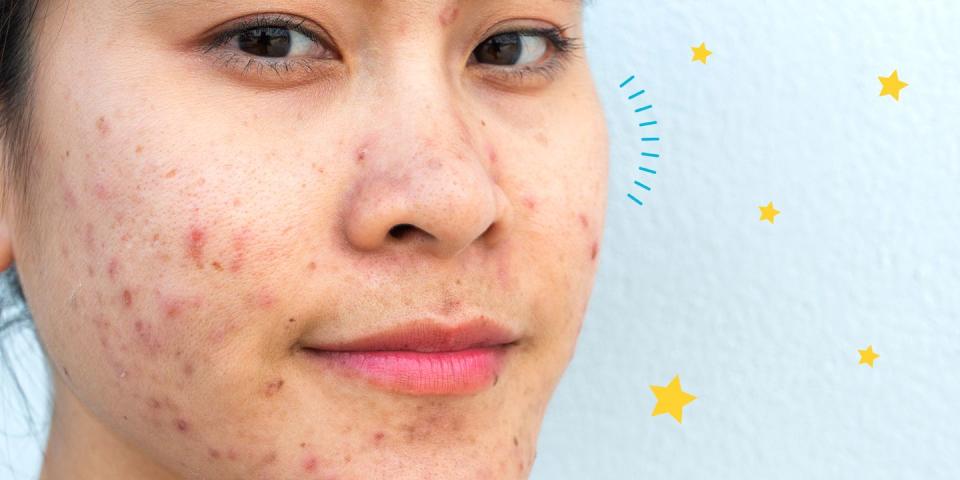5 common acne questions, answered

Clear skin might sound like a straightforward goal, but unless you have a dermatologist on speed dial, it’s more likely to be a marathon than a sprint.
Looking after acne-prone skin means resisting the urge to pop whiteheads and pustules and instead choosing the right products to help manage acne symptoms, spots and the lingering effects of breakouts.
To save your sore skin, we asked an expert dermatologist for her top tips on how to help prevent and treat acne and breakouts. Read on to supercharge your skincare routine.
Help! Why is my skin erupting?
Whether you’re a long-term acne sufferer or you’ve found yourself tackling a condition you thought you’d left behind in your teens, spots are ultimately down to a blockage in your skin.
“Anyone can get acne, but there are certain times in our lives that we’re more at risk,” explains consultant dermatologist Dr Justine Hextall. “The most common time to develop acne is as a teenager, when there’s an increase in the hormones that trigger oil production in the skin. This oil (medically known as sebum), along with dead skin cells, blocks pores. These blocked pores may present as comedones (whiteheads, blackheads) or, once inflamed, spots, pustules or deeper cysts.”
How can I help to treat it?
Those pesky blocked pores can be down to a lot of things. It’s important to make sure that you’re eating well, drinking lots of water and getting enough rest, as well as building a skincare routine that works for you.
“Always make sure unwanted oil, dirt and pollution are removed at the end of the day,” says Dr Hextall. “It may sound counterintuitive, but using a gentle hydrating cleanser that doesn’t leave skin feeling tight and dry is the first step.”
Try washing the day away with Cetaphil Gentle Skin Cleanser or CORSX LOW-PH Good Morning Gel Cleanser for a kind, effective cleanse that won’t overdo it.
Any important ingredients I should be using?
While keeping your skin clean helps to keep it clear, there are some targeted ingredients that can help to treat the acne itself.
“Topical ingredients that help to unblock pores, reduce inflammation and calm acne include benzoyl peroxide, retinoids, salicylic acid and niacinamide,” Dr Hextall explains.
Niacinamide and salicylic acid are widely found in cleansers, toners, serums, face creams and more; simply pick your product and work it into your daily routine. Boots Ingredients Niacinamide Serum can help to bring oily skin back into balance while helping to reduce redness; or try salicylic acid-powered patches that work in as little as two hours. The ZitSticka KILLA Spot Clarifying Patch Kit can help to stop spots becoming angry when used on early breakouts.
If you’re using one of these stronger treatments, like prescription retinoids or over-the-counter benzoyl peroxide, it’s worth making sure you layer them with products that support your skin. “These ingredients, although effective, can be quite drying and irritating to skin. I recommend using a soothing, hydrating moisturiser half an hour after applying these active ingredients,” adds Dr Hextall.
If using a product like Acnecide 5% w/w Gel* to treat your acne, follow it with a gentle moisturiser like Cetaphil Moisturising Lotion to soothe the skin.

What’s with the scarring?
Often, when spots have calmed down you can be left with marks on your skin that take time to fade.
“On closer inspection, what people often believe to be scarring is actually post-acne redness or pigmentation that will fade in time,” explains Dr Hextall.
The good news is, the appearance of pigmentation can be reduced – often at the same time as the spots themselves. “Post-acne pigmentation can be particularly troublesome for people of colour. Topical retinoids which are used to treat acne may reduce this in pigment-prone skin,” says Dr Hextall. “I advise using a topical vitamin C, plus the use of a non-comedogenic sun lotion.”
We recommend trying a product like PIXI Vitamin-C Tonic and helping to protect skin with a product like the La Roche-Posay Anthelios Sun Protection Face Mist, a formula which will help prevent pores from blockages.
Can I stop acne from coming back?
Prevention is always better than cure, but with skin conditions like acne, it’s not quite so clear-cut. Think of it as you would any health concern – the quicker you swoop in to do something about it, the milder it can be.
“If acne can be treated at an early stage with products that reduce inflammation and unblock pores, it can help to lessen or even prevent the development of spots,” confirms Dr Hextall.
Acting quickly is even easier with services like Boots’ Acne Online Clinic, where you can access prescription-only medications for mild to moderate acne without having to visit your doctor. With a quick online consultation and approval from a clinician, you’ll have products specifically recommended to soothe your symptoms, available for home delivery or collection from store.
And with that, it’s time for your best skin yet.
Check in with the Boots Acne Online Clinic** to help you find the right solution for your spots. Shop in store, at Boots.com and on the app
*Contains benzoyl peroxide. Always read the label.
**Subject to clinician approval. Charges apply.
You Might Also Like

